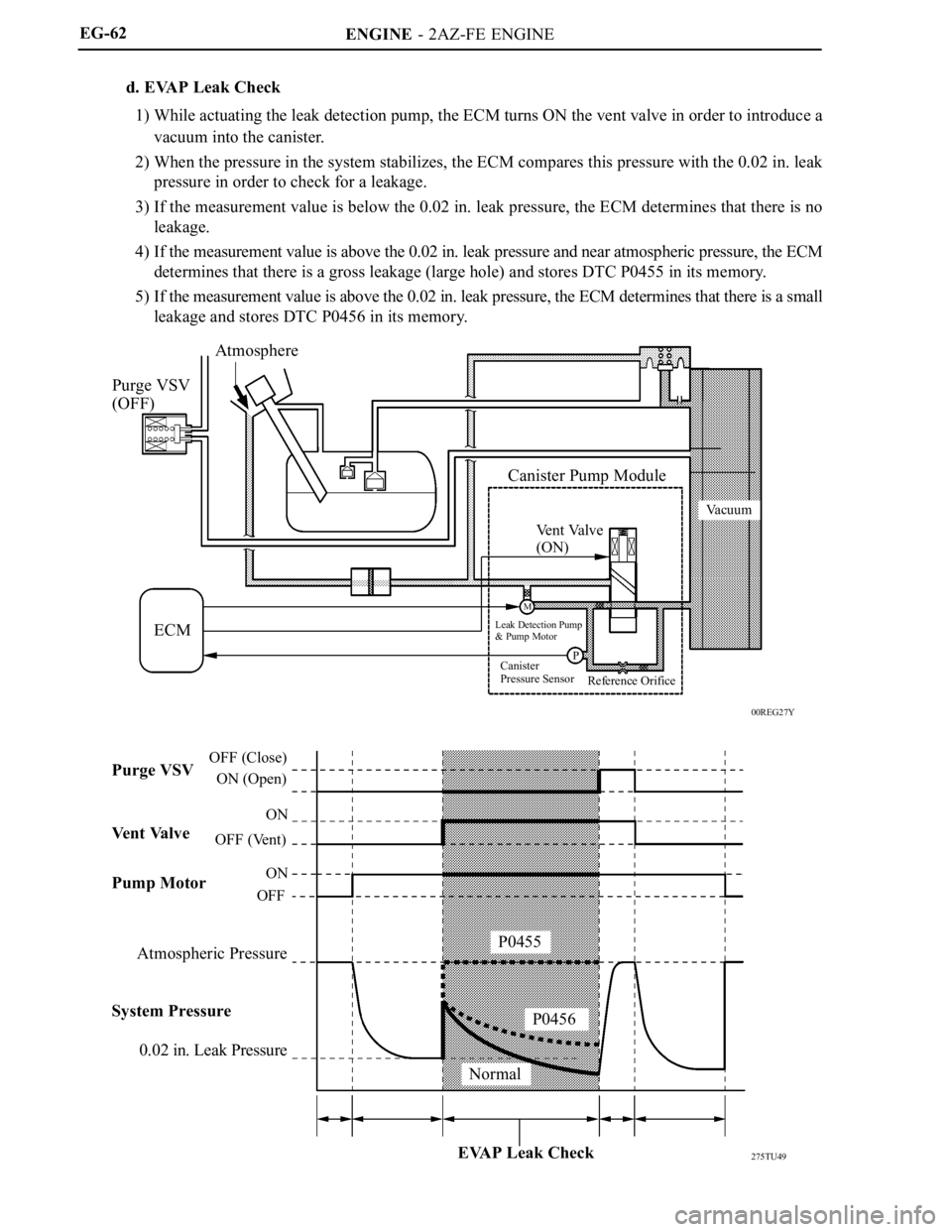sensor TOYOTA RAV4 2006 Service Owner's Manual
[x] Cancel search | Manufacturer: TOYOTA, Model Year: 2006, Model line: RAV4, Model: TOYOTA RAV4 2006Pages: 2000, PDF Size: 45.84 MB
Page 45 of 2000

ENGINE - 2AZ-FE ENGINE
DR011EG25
Camshaft Position Sensor
Engine Coolant
Temperature Sensor
Crankshaft
Position Sensor
Camshaft Timing
Oil Control Valve
Throttle Position
Sensor
ECM
Mass Air Flow Meter Vehicle Speed Signal
221EG16
Crankshaft Position Sensor
Mass Air Flow Meter
Throttle Position Sensor
Engine Coolant Temp. Sensor
Camshaft Position Sensor
Vehicle Speed SignalECM
Target Valve Timing
Feedback
Correction
Actual Valve Timing
Duty-cycle
Control
Camshaft Timing
Oil Control Valve
EG-48
7. VVT-i (Variable Valve Timing-intelligent) System
General
The VVT-i system is designed to control the intake camshaft within a range of 40 (of Crankshaft Angle)
to provide valve timing that is optimally suited to the engine condition. This realizes proper torque in
all the speed ranges as well as realizing excellent fuel economy, and reducing exhaust emissions.
Using the engine speed signal, vehicle speed signal, and the signals from mass air flow meter, throttle
position sensor and engine coolant temperature sensor, the ECM can calculate optimal valve timing for
each driving condition and controls the camshaft timing oil control valve. In addition, the ECM uses
signals from the camshaft position sensor and crankshaft position sensor to detect the actual valve timing,
thus providing feedback control to achieve the target valve timing.
Page 49 of 2000

ENGINE - 2AZ-FE ENGINE
01NEG09Y
01NEG10Y
Air
Conditioning
ECU
Engine Coolant
Temperature SensorFANL
ECM
FA N HCooling Fan
Relay No.3
Cooling Fan
Motor No.2
Cooling Fan
Relay No.1
Cooling Fan
Motor No.1
Low Speed (Series Connection)
High Speed (Parallel Connection) Air
Conditioning
ECU
Engine Coolant
Temperature SensorFA N L
ECM
FA N HCooling Fan
Relay No.3
Cooling Fan
Motor No.2
Cooling Fan
Relay No.1
Cooling Fan
Relay No.2
Cooling Fan
Motor No.1 : CAN
Cooling Fan
Relay No.2
EG-52
8. Cooling Fan Control
On the models with air conditioning, the ECM controls the operation of the cooling fan in two speeds (Low
and High) based on the engine coolant temperature sensor signal and the air conditioning ECU signal. This
control is accomplished by operating the 2 fan motors in 2 stages through low speed (series connection) and
high speed (parallel connection).
Wiring Diagram
Cooling Fan Operation
Air Conditioning ConditionEngine Coolant Temperature C (F)
A / C CompressorRefrigerant Pressure94 (201.2) or lower95.5 (203.9) or higher
OFF1.2 MPa (12.5 kgf / cm2, 178 psi) or lowerOFFHigh
ON1.2 MPa (12.5 kgf / cm2, 178 psi) or lowerLowHighON1.2 MPa (12.5 kgf / cm2, 178 psi) or higherHighHigh
Page 50 of 2000

ENGINE - 2AZ-FE ENGINE
00REG18Y
Front Airbag
Sensor
(RH and LH)
Curtain Shield
Airbag Sensor*
(RH and LH)Airbag
Sensor
Side Airbag
Sensor*
(RH or LH)ECMCircuit
Opening
Relay
Fuel
Pump
Motor
: CANEG-53
9. Fuel Pump Control
A fuel cut control is used to stop the fuel pump when the SRS airbag is deployed at the front collision. In this
system, the airbag deployment signal from the airbag sensor is detected by the ECM, which turns OFF the
circuit opening relay.
After the fuel cut control has been activated, turning the ignition switch from OFF to ON cancels the fuel cut
control, and the engine can be restarted.
*: Models with SRS Driver, Front Passenger, Side and Curtain Shield Airbags
Page 51 of 2000

ENGINE - 2AZ-FE ENGINE
Service Tip
The canister pump module performs the EVAP leak check. This check is done approximately five
hours after the engine is turned off. So you may hear sound coming from underneath the luggage
compartment for several minutes. It does not indicate a malfunction.
The pinpoint pressure test procedure is carried out by pressurizing the fresh air line that runs from
the pump module to the air filler neck. For details, refer to the 2006 RAV4 Repair Manual (Pub.
No. RM01M1U).
EG-54
10. EVAP (evaporative Emission) Control System
General
The EVAP (evaporative emission) control system prevents the vapor gas that is created in the fuel tank from
being released directly into the atmosphere.
The canister stores the vapor gas that has been created in the fuel tank.
The ECM controls the purge VSV in accordance with the driving conditions in order to direct the vapor
gas into the engine, where it is burned.
In this system, the ECM checks the evaporative emission leak and outputs DTC (Diagnostic Trouble
Code) in the event of a malfunction. An EVAP (evaporative emission) leak check consists of an
application of a vacuum pressure to the system and monitoring the changes in the system pressure in order
to detect a leakage.
This system consists of the purge VSV, canister, refueling valve, canister pump module, and ECM.
The ORVR (Onboard Refueling Vapor Recovery) function is provided in the refueling valve.
The canister pressure sensor has been included to the canister pump module.
The canister filter has been provided on the fresh air line. This canister filter is maintenance-free.
The followings are the typical conditions for enabling an EVAP leak check:
Typical Enabling
Condition
Five hours have elapsed after the engine has been turned OFF*.
Altitude: Below 2400 m (8000 feet)
Battery voltage: 10.5 V or more
Ignition switch: OFF
Engine coolant temperature: 4.4 to 35C (40 to 95F)
Intake air temperature: 4.4 to 35C (40 to 95F)
*: If engine coolant temperature does not drop below 35C (95F), this time should be extended to 7hours.
Even after that, if the temperature is not less than 35
C (95F), the time should be extended to 9.5 hours.
Page 52 of 2000

ENGINE - 2AZ-FE ENGINE
00REG22Y
To Intake Manifold
Purge VSV
Purge Air
Line
ECMFuel Tank
Canister Filter
Fresh Air LineRefueling Valve
Canister Pump Module
Ve n t
Va l v e
Leak Detection Pump
& Pump Motor
Canister
Pressure SensorCanisterP M
EG-55
System Diagram
Function of Main Components
ComponentFunction
CanisterContains activated charcoal to absorb the vapor gas that is created in the
fuel tank.
Refueling
Controls the flow rate of the vapor gas from the fuel tank to the canister
when the system is purging or during refueling.
Refueling
Va l v eRestrictor PassagePrevents a large amount of vacuum during purge operation or system
monitoring operation from affecting the pressure in the fuel tank.
Fresh Air LineFresh air goes into the canister and the cleaned drain air goes out into
the atmosphere.
Vent ValveOpens and closes the fresh air line in accordance with the signals from
the ECM.
Canister
Pump ModuleLeak Detection
PumpApplies vacuum pressure to the EVAP control system in accordance
with the signals from the ECM.
p
Canister
Pressure SensorDetects the pressure in the EVAP control system and sends the signals
to the ECM.
Purge VSV
Opens in accordance with the signals from the ECM when the system
is purging, in order to send the vapor gas that was absorbed by the
canister into the intake manifold. In system monitoring mode, this valve
controls the introduction of the vacuum into the fuel tank.
Canister FilterPrevents dust and debris in the fresh air from entering the system.
ECM
Controls the canister pump module and purge VSV in accordance with
the signals from various sensors, in order to achieve a purge volume that
suits the driving conditions. In addition, the ECM monitors the system
for any leakage and outputs a DTC if a malfunction is found.
Page 54 of 2000

ENGINE - 2AZ-FE ENGINE
279EG26
D13N17 279EG25
Fresh Air
Canister
Pressure SensorLeak Detection Pump
Pump Motor
Vane PumpCanister
Pressure SensorVe n t Va l v e
Fresh Air
Canister
Canister Pump Module
Fresh AirVent Valve
Filter Filter
M
Leak Detection Pump
& Pump Motor
Canister
Pressure SensorP
Reference Orifice
[0.5 mm (0.02 in.) Diameter]Filter
To Canister
EG-57
3) Canister Pump Module
Canister pump module consists of the vent valve, leak detection pump, and canister pressure sensor.
The vent valve switches the passages in accordance with the signals received from the ECM.
A DC type brushless motor is used for the pump motor.
A vane type vacuum pump is used.
Simple Diagram
Page 55 of 2000

ENGINE - 2AZ-FE ENGINE
00REG23Y
To Intake Manifold
Atmosphere
Purge VSV
(Open)
ECM
00REG24Y
CloseOpen EG-58
System Operation
1) Purge Flow Control
When the engine has satisfied the predetermined conditions (closed loop, engine coolant temperature
above 74
C (165F), etc.), the stored vapor gas are purged from the canister whenever the purge VSV
is opened by the ECM.
The ECM will change the duty ratio cycle of the purge VSV, thus controlling purge flow volume. Purge
flow volume is determined by intake manifold pressure and the duty ratio cycle of the purge VSV.
Atmospheric pressure is allowed into the canister to ensure that purge flow is constantly maintained
whenever purge vacuum is applied to the canister.
2) ORVR (On-board Refueling Vapor Recovery)
When the internal pressure of the fuel tank increases during refueling, this pressure causes the diaphragm
in the refueling valve to lift up, allowing the vapor gas to enter the canister. Because the vent valve is
always open (even when the engine is stopped) when the system is in a mode other than the monitoring
mode, the air that has been cleaned through the canister is discharged outside the vehicle via the fresh
air line. If the vehicle is refueled in the monitoring mode, the ECM will recognize the refueling by way
of the canister pressure sensor, which detects the sudden pressure increase in the fuel tank, and will open
the vent valve.
Page 57 of 2000

ENGINE - 2AZ-FE ENGINE
00REG25Y
D13N22
Atmosphere
Purge VSV
(OFF)
ECMCanister Pump Module
Ve n t Va l v e
(OFF)
Leak Detection Pump
& Pump Motor
Canister
Pressure Sensor
Purge VSV
Vent Valve
Pump Motor
System PressureON (Open)
OFF (Close)
ON
OFF (Vent)
ON
OFF
Atmospheric Pressure
0.02 in. Leak Pressure
Atmospheric Pressure Measurement
P
M
EG-60
b. Atmospheric Pressure Measurement
1) When the ignition switch is turned OFF, the purge VSV and vent valve are turned OFF. Therefore,
the atmospheric pressure is introduced into the canister.
2) The ECM measures the atmospheric pressure through the signals provided by the canister pressure
sensor.
3) If the measurement value is out of standards, the ECM actuates the leak detection pump in order
to monitor the changes in the pressure.
Page 58 of 2000

ENGINE - 2AZ-FE ENGINE
00REG26Y
275TU48
Atmosphere
Purge VSV
(OFF)
ECMCanister Pump Module
Ve n t Va l v e
(OFF)
Leak Detection Pump
& Pump Motor
Canister Pressure
Sensor
Reference Orifice
Purge VSV
Vent Valve
Pump Motor
System PressureON (Open)
OFF (Close)
ON
OFF (Vent)
ON
OFF
Atmospheric Pressure
0.02 in. Leak Pressure
0.02 in. Leak Pressure Measurement
M
P
EG-61
c. 0.02 in. Leak Pressure Measurement
1) The vent valve remains OFF, and the ECM introduces atmospheric pressure into the canister and
actuates the leak detection pump in order to create a negative pressure.
2) At this time, the pressure will not decrease beyond a 0.02 in. leak pressure due to the atmospheric
pressure that enters through a 0.02 in. diameter reference orifice.
3) The ECM compares the logic value with this pressure, and stores it as a 0.02 in. leak pressure in its
memory.
4) If the measurement value is below the standard, the ECM will determine that the reference orifice
is clogged and store DTC (Diagnostic Trouble Code) P043E in its memory.
5) If the measurement value is above the standard, the ECM will determine that a high flow rate pressure
is passing through the reference orifice and store DTCs (Diagnostic Trouble Codes) P043F, P2401
and P2402 in its memory.
Page 59 of 2000

ENGINE - 2AZ-FE ENGINE
00REG27Y
275TU49
Purge VSV
(OFF)Atmosphere
ECMCanister Pump Module
Vent Valve
(ON)
Leak Detection Pump
& Pump Motor
Canister
Pressure Sensor
M
P
Reference Orifice
Va c u u m
Purge VSV
Ve n t Va l v e
Pump Motor
System PressureOFF (Close)
ON (Open)
ON
OFF (Vent)
ON
OFF
Atmospheric Pressure
0.02 in. Leak Pressure
EVAP Leak CheckP0455
P0456
Normal EG-62
d. EVAP Leak Check
1) While actuating the leak detection pump, the ECM turns ON the vent valve in order to introduce a
vacuum into the canister.
2) When the pressure in the system stabilizes, the ECM compares this pressure with the 0.02 in. leak
pressure in order to check for a leakage.
3) If the measurement value is below the 0.02 in. leak pressure, the ECM determines that there is no
leakage.
4) If the measurement value is above the 0.02 in. leak pressure and near atmospheric pressure, the ECM
determines that there is a gross leakage (large hole) and stores DTC P0455 in its memory.
5) If the measurement value is above the 0.02 in. leak pressure, the ECM determines that there is a small
leakage and stores DTC P0456 in its memory.